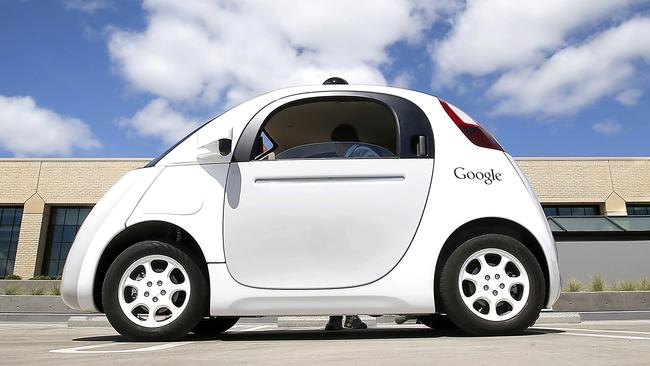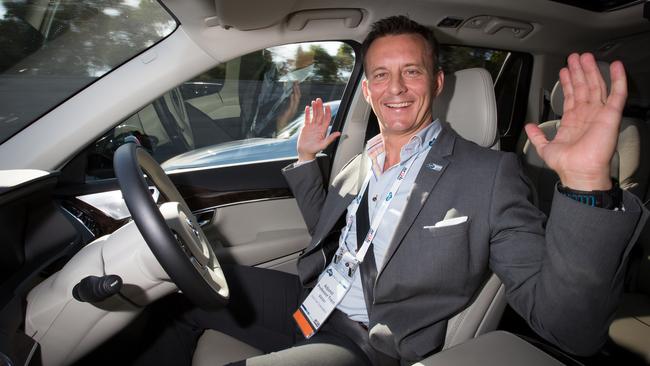Look, no hands! Driverless car era is just round the corner
We’re speeding down the technology highway to the age of the driverless car — if only state legislation can catch up.

As the era of the driverless car draws near, should we be quaking in our boots? Should we worry about the prospect of a malfunction that causes a crash? Will we rue the day we handed over the steering wheel to machines?
During a demonstration of an autonomous Volvo on Adelaide’s Southern Expressway last weekend, I had a chance to decide the answer to these questions. So did the other occupants of the car, which included South Australian Premier Jay Weatherill, state Transport Minister Stephen Mullighan and Australian Road Research Board Group head Gerard Waldron. The ARRB Group is the key research body promoting driverless cars in Australia.
None of us found himself quaking in his boots. The only time I was shaking was on the turbulent flight from Sydney after thunderstorms temporarily closed Sydney airport. My life certainly depended on computers then. We regularly rely on autopilot systems in planes and many of us have experienced unmanned overseas airport shuttles. I recently travelled on the subways of Taipei and Singapore with no human driver. We’ve already placed our travels under machine control without realising it.
Volvo managing director Kevin McCann says his company can have driverless cars on Australian roads by 2020 if state laws across the country are changed. South Australia already has introduced legislation to allow driverless vehicles and Western Australia has included autonomous roads in its intelligent transport systems master plan.
Transurban, which manages and controls urban toll road networks, is keen to prepare Australian roads for autonomous use, having conducted trials in the US. And car-sharing firm GoGet has been researching self-driving vehicles in a project with the University of NSW. Volvo is by no means the sole manufacturer of autonomous cars (the industry prefers “autonomous” to “driverless”) with Audi, Nissan, Toyota, Mercedes, General Motors and Tesla also in the race.
360° video of the historic driverless vehicle journey with South Australia Premier Jay Wetherill. Drag your cursor across the video to see the car and its participants from all angles. You will need Google Chrome or Firefox to view it.
So the momentum is quickly gathering pace. What’s emerging is at least two contrasting takes on driverless technology.
First, carmakers such as Volvo are building vehicles with semi-autonomous driving features that you can mostly use now — provided you keep your hands on the wheel. They relieve you of steering on an open highway by keeping you in a designated lane, keep you below the speed limit, place you at a set distance behind the car ahead and, in heavy traffic, automatically stop and start in sync with the car in front. There’s automatic emergency braking should the car detect a pedestrian or obstacle in its path using collision avoidance technology.
There are other aids such as blind-spot detection, where the car warns you about a vehicle you can’t see in your side mirror. The Volvo doesn’t switch lanes automatically, but Tesla last month announced an autopilot feature that will. And, of course, machine assistance with parking is common.
The big car companies are targeting highway travelling for autonomous use. In Volvo’s case, commuters on gridlocked arterial roads can switch on these features, then sit back, read emails, eat a sandwich or chat away while their car edges towards their city offices. Maybe you can take a nap, as long as you don’t sleep through warning buzzers telling you to take control again.
But you are not in autonomous mode all the time. Just as you wouldn’t turn on autopilot in a plane on the tarmac, you won’t switch on autonomous mode in the car except where it is authorised, such as on open roads upgraded for driverless use.
It’s not ubiquitous autonomous driving but it’s an achievable first step, with governments having to upgrade only a limited number of arterial roads. Letting your car take over completely on freeways, especially in bumper-to-bumper traffic, is likely to be popular.

The second take on driverless transport is Google’s. There’s no slipping back into manual driving contemplated here. It’s about a different era of driving. Google is using its own navigation system in purpose-built autonomous bubble cars and Toyota Prius and Lexus vehicles. These cars have clocked up more than 1.6 million kilometres in tests and on the open road. Rather than just concentrating on highway use, they’ve also been making domestic trips around Mountain View, California, and Austin, Texas.
Google founder Sergey Brin says the search giant will have driverless cars on the market by 2018, but there is nothing to suggest the company’s bubble cars will come to Australia then. For starters, Google has tended to be US-centric in rolling out its more exotic products such as Google Glass and fibre internet.
There’s a mountain of work needed to make their cars technically viable here. Google cars have a laser sensor on the top that generates a detailed 3-D image of everything it sees, with a range up to what Google says is “two football fields” away. That gives it an ability to identify pedestrians, cyclists, traffic lights and other cars in a normal suburban street with eagle-eye precision. But this system is supplemented by Google having accumulated huge amounts of data from earlier laser street mapping. That data goes well beyond your average Google Map. So Google cars don’t have to process an entire streetscape at one time.
It has been reported that this data includes the height of every traffic light and the exact position of every kerb and other piece of road infrastructure. Fresh mapping data created by one car is then available to all. It seems Google caches road travel data for further use, just as it does browser history.
But this data doesn’t exist in Australia. The cache is empty. It make take several years before Google cars are viable here for public use. And will Google cars be sexy enough in terms of design and internal features that make them comfortable?
The weekend trials threw up many interesting issues. The Volvo XC90’s ability to automatically keep within its designated lane using camera technology raises the question of whether white lines on the road could eventually become the virtual railway tracks of the 21st century.
This automatic lane-keeping capability could be adapted to steer a bus down a busway or a freight truck down a designated lane as if they are on virtual railway tracks. Shuttle services and driverless road freight convoys are envisaged by ARRB Group, and Rio Tinto already deploys driverless trucks in the Pilbara.
Valet parking is another area that’s quickly becoming viable. Combine the self-steering capability with park-assist features, and you’ve got a car that can go off by itself, find a space then park in it. You’d need to deck the parking station with appropriate signage and line marking, but it seems almost possible now. We’ve seen variants of this, such as BMW’s demonstration of its i3 that can fetch itself from the garage and park outside your front door, and park itself in a multistorey carpark.
Then there’s the discussion around ethics: would a vehicle be programmed to decide who to protect in a crash? Would it choose you, or the motorcyclist you’d otherwise hit full-on if the car were to avoid crashing down an embankment?
Finally, though, no one is going to compel you to give up the pleasures of driving.
At least in this era, you’re in ultimate control, not the machines.


